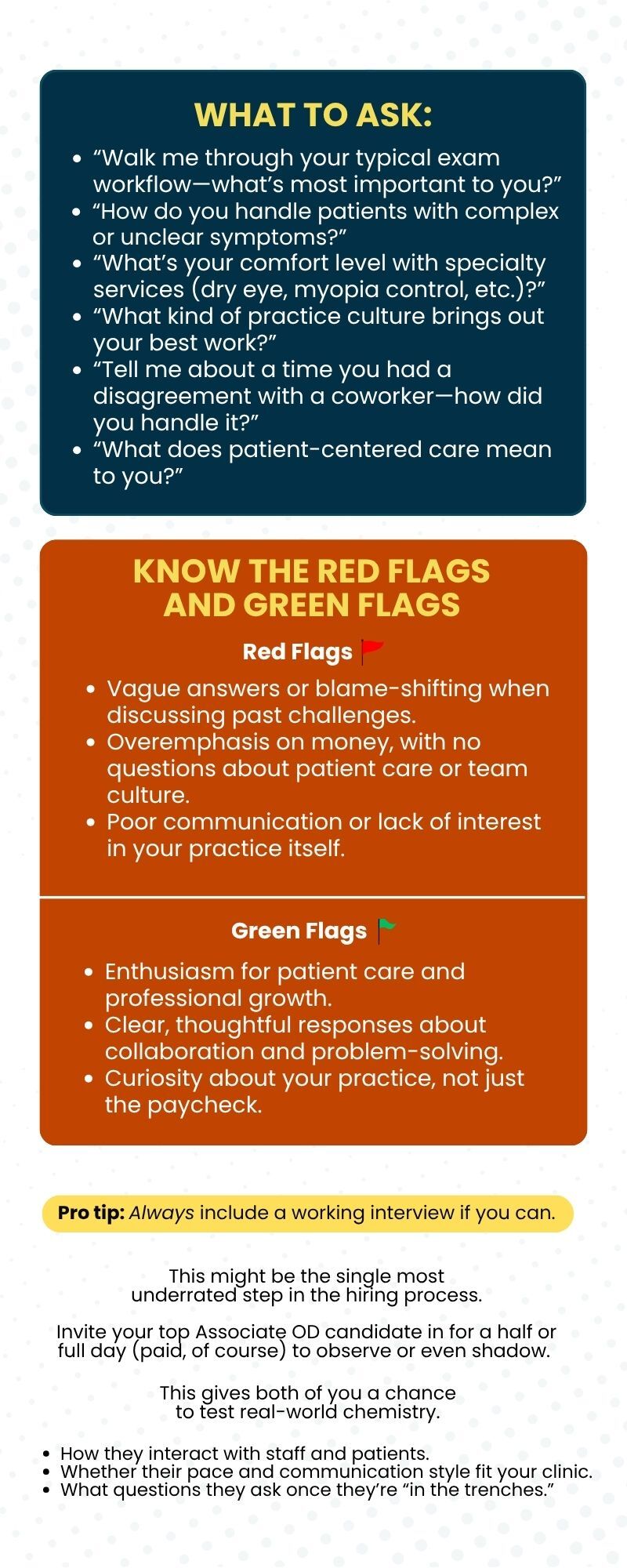So—you’ve decided it’s time to hire your first Associate OD.
Congrats! That’s a huge milestone for your practice. It means you’re growing, your patient load is thriving, and you’re ready to stop wearing all the hats, but how do you know you’re ready?
How to Know You’re Ready to Hire an Associate OD
Hiring your first Associate OD is a big move. It’s exciting, yes—but also a little terrifying. How do you know if you’re actually ready, or if you’re just burnt out from back-to-back appointments and dreaming of someone to share the load?
Here are some clear signs that it’s time to bring in reinforcements—and we’re going to walk through them, step by step.
You’re drowning in patient volume
If your schedule is booked out for weeks, patients are dropping off due to wait times, or you’re staying late every day to squeeze people in—this is your flashing neon sign. If you’re turning away new patients or losing existing ones because you’re at max capacity. That’s your go sign.
Your finances can sustain it
Before you bring on an Associate OD, take a hard look at your financials:
- Are you consistently generating enough revenue to cover another salary?
- Can you afford onboarding costs, benefits, and a potential ramp-up period?
- Do you understand your break-even point with an additional provider?
An Associate OD should help grow your practice, not stretch it thin. If you’re unsure, consult with a healthcare CPA or practice management consultant to run the numbers.
You already have a good system, culture and space ready
Bringing on an Associate OD isn’t just a hiring decision—it’s a systems decision.
Ask yourself:
- Is your EHR workflow efficient enough for two providers?
- Do you have exam room availability during key hours?
- Is your team trained and ready to support another OD?
Just as important: are you ready mentally to share patients, decision-making, and your practice culture with someone new? You don’t want to hire an Associate OD into chaos. A strong onboarding process, a clear mission, and a collaborative mindset go a long way in making sure this new relationship sticks.
Now that’s out, and you think that your practice is set up for your first Associate OD, what’s the next step?
What to Know Before You Start the Associate OD Hiring Process
Big move. But before you throw a job post online and cross your fingers, let’s make sure you’re actually prepared to attract the right person.
So here’s a short questionnaire to ask yourself before anything else:
- Do I know exactly what I want this associate OD to do?
- Will they see primary care patients, or specialize in a niche (pediatrics, dry eye, etc.)?
- Are you looking for someone full-time, part-time, or flexible?
- Will they eventually buy into the practice or stay as an employee?
- What kind of associate OD am I looking for? (Clinical strengths, communication style, career goals etc)
- Is my practice attractive to the type of associate OD I want to hire?
- Do I have Competitive pay and benefits?
- Do I offer a healthy work-life balance?
- Does my clinic have modern equipment and a clean workflow?
- Am I open to coaching and collaboration?
- Do I have time (and patience) to train and integrate someone new?
- Can I delegate without micromanaging?
You don’t need to have everything figured out before hiring an Associate OD, but you do need clarity on your goals, readiness, and expectations. This sets the stage for a smoother hiring process—and a stronger long-term fit.
Avoiding Common Mistakes When Hiring Your First Associate OD
Once you have answered the questionnaire above and got your specifics laid out, here’s our advice as recruiters in the Eye Care for 7+ years.
We’ve seen too many great practices struggle, not because they couldn’t find an optometrist, but because they skipped a few critical steps.
Here’s what NOT to do:
1. Rushing the hire.
When you rush, you miss red flags. You settle. You make decisions based on panic instead of purpose.
Instead:
- Take the time to define your ideal candidate.
- Ask deeper interview questions—not just about clinical skills, but about goals, communication, and personality.
- Sleep on it. Seriously. No one ever regretted making a big decision in 24 hours.
2. Underestimating onboarding time
If your onboarding plan is “we’ll figure it out as we go,” you’re setting both of you up for frustration. Even the most experienced OD needs time to adjust to your systems, patients, and practice culture.
Instead plan for:
- At least a few weeks of hands-on training and shadowing.
- Clear documentation of your processes (EHR, billing, protocols, etc.).
- Regular check-ins to answer questions and offer feedback.
3. Skipping cultural alignment with the Associate OD.
Skills matter. So do credentials. But culture fit is what gets you a working and long-term employee-employer relationship.
Look for alignment in:
- Patient care philosophy: Do they share your approach to care and service?
- Communication style: Can they take (and give) feedback in a healthy way?
- Growth mindset: Are they in it to build something—not just clock in and out?
Where and How to Find the Right Associate OD
So—you’re clear on what you need. You’ve avoided the rookie mistakes. The truth is, great optometrists are out there. But if your job post sounds like a checklist and your outreach is limited to a Facebook group you haven’t checked in six months… It’s going to be a slog.
1. Use the right channels.
Leverage AOAExcel, Monster or Eye To Eye Careers. These attract professionals actively looking in your niche. Better yet, get help from Eye Care industry specific recruiters who have a vetted pool of candidates and can fast-track your search for a high-quality Associate OD. Also let your reps, colleagues, or alma mater know you’re hiring. Some of the best Associate ODs come from word of mouth.
2. What to include in your job post.
A job ad for an Associate OD shouldn’t read like a legal form—it should tell a story. One that shows what makes your practice a place they’ll want to grow, not just work. Basic contents should be competitive compensation & benefits, the practice culture, team environment and growth opportunities.
3. Expect a challenge—and plan for it
Some candidates ghost. Some look great on paper but flop in interviews. And sometimes the timing just doesn’t align.
That’s why it helps to. Start early. Hiring always takes longer than you think. Stay patient and consistent with outreach. Get help if you need it—especially if you’re hiring for the first time.
Interviewing and Evaluating Associate OD Candidates
Your inbox finally has a few promising resumes. Now what? Let’s get into how to do this right—from what to ask, to what to watch out for, to making sure you’re not hiring blind. Here’s an infographic you can save.

Hire with confidence with our 90 day guarantee!
Hiring your first Associate OD is a big leap—but it doesn’t have to feel like a gamble. Want to have a safety net? We specialize in helping practice owners like you hire the right Associate OD the first time—and we back it up with a 90-day guarantee.
If the fit isn’t right within the first 90 days, we’ll help you find a replacement—at no extra cost.
Here’s what your first three months with a new Associate OD might look like:
First 30 Days:
- Introduce your Associate OD to the team, systems, and daily rhythm.
- Provide a checklist of procedures, logins, and contacts.
- Shadow days with you or another provider to understand patient flow and expectations.
60 Days:
- Begin transitioning independent patient care.
- Offer feedback on clinical style, communication, and billing efficiency.
- Hold regular check-ins to answer questions and reinforce expectations.
90 Days:
- Review performance and alignment with your goals.
- Encourage open dialogue—what’s working, what’s not, and where they want to grow.
- Discuss long-term development and future responsibilities.
Remember, confidence grows when your new Associate OD knows what’s expected—and sees that you’re invested in their success.
Even the most self-sufficient Associate OD needs a safety net early on.
Here’s what to prioritize:
- Weekly Check-ins: Keep them short but meaningful. This isn’t just about metrics—it’s about culture, patient interactions, and support.
- Clear Points of Contact: Who does the Associate OD go to for scheduling questions? Billing quirks? Angry patients? Make it crystal clear.
- Mentorship Mindset: Even if you’re busy, offer open-door moments. Let them know you’re there—for advice, encouragement, or just a quick “you’ve got this.”


